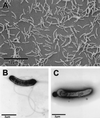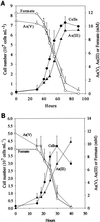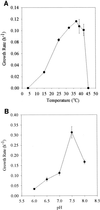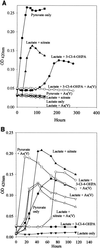Isolation and characterization of a novel As(V)-reducing bacterium: implications for arsenic mobilization and the genus Desulfitobacterium
- PMID: 11722908
- PMCID: PMC93345
- DOI: 10.1128/AEM.67.12.5568-5580.2001
Isolation and characterization of a novel As(V)-reducing bacterium: implications for arsenic mobilization and the genus Desulfitobacterium
Abstract
Dissimilatory arsenate-reducing bacteria have been implicated in the mobilization of arsenic from arsenic-enriched sediments. An As(V)-reducing bacterium, designated strain GBFH, was isolated from arsenic-contaminated sediments of Lake Coeur d'Alene, Idaho. Strain GBFH couples the oxidation of formate to the reduction of As(V) when formate is supplied as the sole carbon source and electron donor. Additionally, strain GBFH is capable of reducing As(V), Fe(III), Se(VI), Mn(IV) and a variety of oxidized sulfur species. 16S ribosomal DNA sequence comparisons reveal that strain GBFH is closely related to Desulfitobacterium hafniense DCB-2(T) and Desulfitobacterium frappieri PCP-1(T). Comparative physiology demonstrates that D. hafniense and D. frappieri, known for reductively dechlorinating chlorophenols, are also capable of toxic metal or metalloid respiration. DNA-DNA hybridization and comparative physiological studies suggest that D. hafniense, D. frappieri, and strain GBFH should be united into one species. The isolation of an Fe(III)- and As(V)-reducing bacterium from Lake Coeur d'Alene suggests a mechanism for arsenic mobilization in these contaminated sediments while the discovery of metal or metalloid respiration in the genus Desulfitobacterium has implications for environments cocontaminated with arsenious and chlorophenolic compounds.
Figures






References
-
- Aggett J, Kriegman M R. The extent of formation of arsenic(III) in sediment interstitial waters and its release to hypolimnetic waters in Lake Ohakuri. Water Res. 1988;22:407–411.
-
- Ahmann D, Roberts A L, Krumholz L R, Morel F M M. Microbe grows by reducing arsenic. Nature. 1994;371:750. - PubMed
-
- Ahmann D, Krumholz L R, Hemond H F, Lovley D R, Morel-Francois M M. Microbial mobilization of arsenic from sediments of the Aberjona watershed. Environ Sci Technol. 1997;31:2923–2930.
-
- Belzile N. The fate of arsenic in sediments of the Laurentian Trough. Geochim Cosmochim Acta. 1988;52:2293–2302.
-
- Belzile N, Tessier A. Interactions between arsenic and iron oxyhydroxides in lacustrine sediments. Geochim Cosmochim Acta. 1990;54:103–109.
Publication types
MeSH terms
Substances
Associated data
- Actions
LinkOut - more resources
Full Text Sources
Molecular Biology Databases
Research Materials

